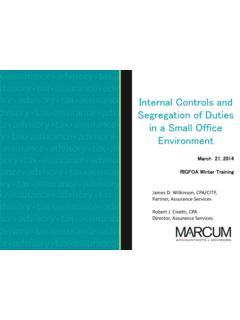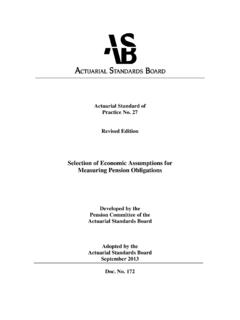Transcription of Evaluating Pension/OPEB Obligations Under …
1 Evaluating Pension/OPEB ObligationsUnder Standard & Poor s LocalGovernment GO CriteriaPrimary Credit Analyst:Katilyn Pulcher, ASA, CERA, Chicago (1) 312-233-7055; Contact:Jeffrey J Previdi, New York (1) 212-438-1796; Of ContentsMagnitudeTimeframeTrendsManageri al ActionsMarket Analysis Versus Credit Analysis: Standard & Poor's ViewNotesRelated Criteria And 19, 2013 11230417 | 300126912 Evaluating Pension/OPEB Obligations UnderStandard & Poor s Local Government GOCriteriaPension and other postemployment benefit ( opeb ) Obligations are measured Under many sets of assumptions andmethods and reported according to different sets of standards . Thus, various metrics can be used to evaluate thefinancial health of a pension or opeb plan and its plan sponsor.
2 This article will explain some of the metrics Standard& Poor's Ratings Services uses Under our recently released local government general obligation (GO) criteria tofurther evaluate the risks posed by these liabilities. According to the criteria, the primary focus of our analysis of a localgovernment's pension or opeb liability is not that the liability will grow or the funded ratio will fall, but whether itrequires significant or significantly increasing--contributions over the medium term. Limited resources or no credibleplan for how to pay for these benefits could exacerbate the credit analyses evaluate a local government's near- to medium-term budget stress caused by payments of pensionor opeb contributions and management's actions to reduce that stress.
3 We recognize that most local governmentsparticipate in multiple-employer, cost-sharing, state-run pension or opeb plans, leaving them with few, if any, optionsto lower the underfunded liability and control the growth rate of their contributions. This focuses our attention on thecontributions themselves and the local government's strategy for how to fund them, rather than the size of theunfunded Standard & Poor's new local government GO criteria, we make a negative qualitative adjustment to a localgovernment's debt and contingent liabilities score if it has "an unaddressed exposure to large unfunded pension orOPEB Obligations , leading to accelerating payment Obligations over the medium term that represent significant budgetpressure.
4 If there is a plan to address the Obligations , the final score worsens by one point; otherwise, the scoreworsens by two points." (See table 14 of the local GO criteria.) For us to determine whether to apply the adjustment,we consider the variables raised by the criteria: Magnitude, Timeframe, Trends, and Managerial assess each of these variables to determine the credit impact these Obligations can primary source of quantitative data for this portion of a Standard & Poor's GO credit analysis will be financialstatements; the secondary source will be actuarial valuation budget impacts can be measured with a carrying charge. For our purposes, a local government's combinedpension and opeb carrying charge is the sum of its required pension contribution(s)(1), and opeb contribution(s)(2), 19, 2013 21230417 | 300126912measured as a percentage of its total governmental funds expenditures.
5 Note that if a local government sponsors orparticipates in more than one pension plan or more than one opeb plan, the required contributions to all plans will besummed for this calculation. In this way, we can determine the total portion of the most recent annual budgetdedicated to pension and opeb our new local GO criteria, we would consider a combined pension and opeb carrying charge approaching orexceeding 10% elevated, leading to further review. A carrying charge at this level warrants further review, in our view,because it could be a marker of significant budget pressure in the medium term, if not currently. However, we willconsider whether the carrying charges are elevated because a local government is intentionally overfunding theactuarially required amounts (in the case of a pension plan) in an effort to accelerate the pre-funding of its recognize that substantial flexibility to increase revenues or decrease nonpension- and opeb -related expenditurescould allow a local government to absorb carrying charges of 10% or higher into its budget without undue stress and,conversely, that limited flexibility could indicate carrying charges below 10% would cause stress.
6 As such, Standard &Poor's will analyze the magnitude of each local government's carrying charge in relation to the magnitude of its fiscalflexibility, as also review opeb carrying charges separately from pensions. These benefits, unlike pensions, typically do not vestand, thus, are not pre-funded because they can be taken away or modified if state laws do not expressly prohibit this orthey are not contractual. Under our new local GO criteria, opeb carrying charges exceeding 5% and limited flexibilityto change or amend these benefits could also be a marker of significant budget pressure in the medium term,warranting consideration of the negative adjustment to the debt score, if the government does not have resourceflexibility.
7 We will consider whether the opeb carrying charge is elevated because a local government is funding morethan its pay-as-you-go-cost in an effort to pre-fund the liability. The size of the opeb carrying charges will also beevaluated relative to the ability and political will to adjust the benefits, control costs, adjust other expenditures, or raiseadditional revenues to avoid budget pressure in the medium assess medium-term carrying charge growth by reviewing the magnitude of the Obligations and--for pensionplans--the funded ratios. opeb plans are typically unfunded if the benefits do not vest and can be reduced or , a local government that sponsors or participates in an opeb plan that is entirely unfunded or has a lowfunded ratio will not necessarily receive a negative adjustment to its debt and contingent liabilities score because itmay not lead to medium-term budget start by reviewing the largest pension plan the government sponsors and/or participates in because, generallyspeaking, larger Obligations require larger contributions and, consequently, pose greater credit risk than smaller example.
8 The nominal amount of an actuarially required contribution for a 90% funded multibillion-dollar liabilitywill be much larger than the contribution for a plan with a $500,000 liability that is 60% funded. However, a plan thathas an extremely low funded ratio, such as 40%, regardless of how large or small its liability, bears further review as itcould lead to increasing contributions in the medium liability we review is determined by the type of plan the local government sponsors and/or participates in. Forthose in multiple-employer cost-sharing plans, a low funded percentage of the overall plan will lead to increasedcontributions for all, as opposed to specific governments participating in the plan.
9 As such, we will review the 19, 2013 31230417 | 300126912 Evaluating Pension/OPEB Obligations Under Standard & Poor s Local Government GO Criteriafunded ratio for that type of plan to try to determine if it will lead to increasing contributions. In an agentmultiple-employer or single-employer plan, we will review the liability specific to the local government we are addition, Standard & Poor's will analyze other plans if it appears the magnitude of their corresponding contributionscould substantially increase in the medium term, thereby causing financial pressure for the local carrying charges can increase rapidly when a pension plan is underfunded. If a low funded ratio hasn't alreadyled to increased contributions, it is likely in the medium term.
10 If contributions are increasing, local governments couldbe forced to pay them in ways that weaken credit quality, such as using operating reserves. To assess whether a plan isunderfunded, Standard & Poor's will look at its actuarial funded ratio(3), which indicates the sufficiency of the assetsset aside in a trust to fund the liabilities due. While the ideal pension plan actuarial funded ratio is 100%, an actuarialfunded ratio of 80% or greater, in our opinion, represents adequate progress toward funding future liabilities. Werecognize that pension liabilities are long-term Obligations and that funded levels may fluctuate over time. If theactuarial funded ratio(s) of the pension plan(s) a local government participates in or sponsors is less than 80%, thiscould represent evidence of future carrying charge growth and will be an area of analytic analyses, using the new local government criteria, seek to be forward-looking and identify projected continuedcredit strength or deterioration.







